Spam kimbap is one of the most classic and popular types of kimbap. It's loaded with veggies, pickled radish, and Spam and rolled up in a sheet of seaweed and rice. Kimbap is great for picnicking, easy meals for outdoor events, and as a grab-and-go meal any time of the day!

If you've never tried kimbap, they are sort of like Korean style sushi rolls with assorted vegetables and protein of your choice, whether it be meat, egg, or seafood.
Our favorite kimbap is between a good, classic Spam kimbap or tuna mayo kimbap. They are just soooo good! Plus, they make for great picnic food, food you can bring on fishing trips, and meals on the go.
If you're looking for more Korean dishes, you may also like our beef bulgogi with vegetables, japchae (Korean glass noodles stir fry), easy bibimbap with ground beef.
Jump to:
Kimbap variations
You can almost use any fillings to make any type of kimbap rolls you want, so be as creative as you'd like! But here are a list of some of the most popular/classic kimbap:
- Spam/Korean ham kimbap
- Tuna kimbap
- Egg kimbap
- Kimchi kimbap
- Imitation crabmeat kimbap
- Bulgogi kimbap
Ingredients
Please scroll down to the recipe card for the ingredient quantities!
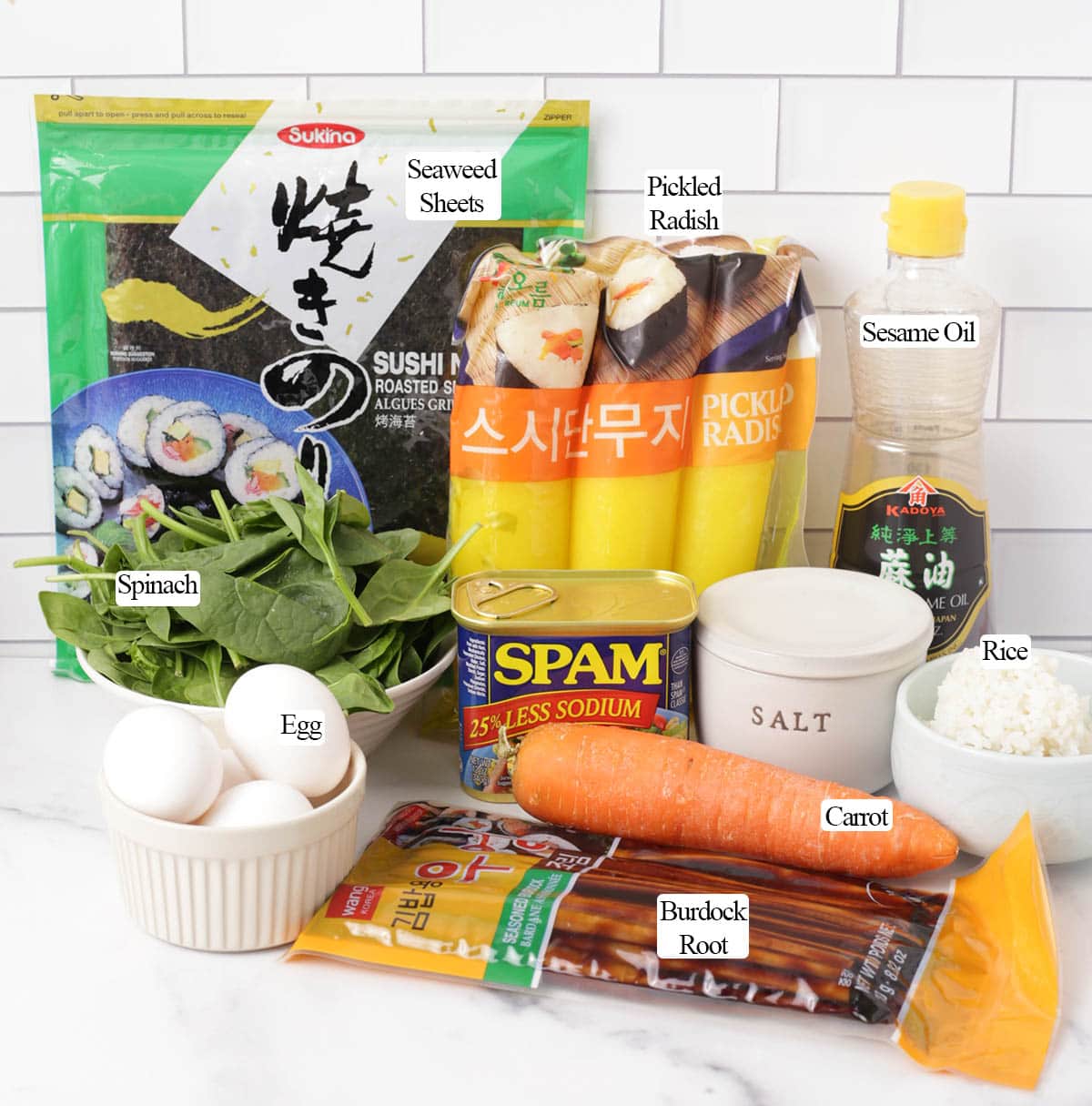
- Cooked medium grain white rice - This is the preferred rice for making kimbap, but you can also use sushi rice as well. For kimbap, you'll want to cook the rice a tad bit drier than normal, because it'll be mixed with seasonings which will cause it to become gummy and broken if the rice is just rice.
- Spam - It can be your preferred luncheon meat. You can even use Korean Ham if you can find it at your local Asian store. We used the light sodium Spam.
- Eggs - We used large eggs.
- Spinach - Baby spinach is perfect. If you want more spinach, you can double the amount as well.
- Carrot - Our carrots from our local Asian market were pretty huge. If yours are a little smaller, you may need to use 2. Also, we recommend cutting your carrots into long matchsticks so that it's easier to keep them organized after sautéing, but regular julienne is fine too.
- Danmuji - This is also known as yellow pickled radish. It's tangy and savory. You'll usually find them in the refrigerated aisle in vacuumed bags. They're almost neon yellow, so you'll easily see them.
- Nori - This is just large dry seaweed sheets, also known as sushi seaweed.
- Toasted sesame oil - This is for seasoning the spinach and the rice. It also helps making the rice less tacky.
- Fine salt - For seasoning the vegetables and rice. We recommend fine salt because it'll be much easier to dissolve and season the rice with. For the vegetables, you could use coarse salt or Kosher salt if you prefer.
- Sesame seeds (optional for garnish)
- Oil (as needed for cooking)
- Burdock roots (optional)- This is a classic Korean ingredient but can be hard to find. They are marinated in a soy based marinade and usually vacuum packed. If you can't find them, you can totally omit them. You can see a picture of it below.

How to make spam kimbap
Although it looks like a lot of steps and can look intimidating, kimbap is actually really easy to make. There's just a few steps to follow for each ingredients so that your kimbap rolls are as tasty and aesthetic as possible.
For the spinach:
1. Bring a pot of water to a boil. Place the spinach into the boiling water and cook for about 15 to 30 seconds, or until the spinach is wilted and turns a vibrant, dark green.
2. Drain the spinach and rinse with cold water until completely cooled. Firmly squeeze the spinach to remove excess water. Repeat with the rest of the spinach.
🌟 Pro tip: Place a comfortable handful of spinach in your hand when squeezing. Too much will make it hard to squeeze and with too little, we tend to squeeze it too hard.
3. Transfer the spinach into a bowl, and season with ¼ teaspoon of fine salt and ½ tablespoon of sesame oil. Mix well and set aside.

For the eggs:
1. Beat the eggs and add ¼ teaspoon of fine salt. Mix well.
2. In a large nonstick pan over medium heat, add a couple tablespoons of oil. Once the oil is hot, pour half of the the beaten eggs into the pan. Let the eggs cook until they are 70 to 80 percent set. Then start folding the egg over itself from one side, about 2 inches. Keep repeating that 1 to 2 more times.
3. Once the egg has been folded about half way, pull it to one side, with the folded up side at the smaller side of the pan. If needed, add a little more oil in the pan, then pour the remaining beaten eggs into the side of the pan where the egg is not folded. Repeat the cooking process and keep folding until the roll completely rolled up and is about 4 to 5 inches in width.
4. Remove the egg from the pan and set aside to cool. Once it's cool enough to handle, cut the egg into 7 even strips, lengthwise. Set aside.

For the Spam:
1. Cut the Spam into 15 equal logs. You'll have 1 extra log. Snack on it or set it aside for something else.
2. In the same large nonstick pan for the eggs, add very small amount of oil and heat it over medium high heat. Once the pan is hot, place the Spam logs in the pan in a single layer. Sear the Spam on each side until golden brown, about 1 to 2 minutes per side. Remove from the pan and set aside.
🌟 Pro tip: You won't need much oil at all when searing Spam. If you use too much oil, it'll be harder for the Spam to brown and the oil will likely splatter more. Plus, some fat will also render from the Spam. So if needed, you can use some paper towel to soak up excess fat/oil from the pan.

For the carrots:
1. In the same large nonstick pan over medium to medium high heat, add a couple tablespoons of oil. Once the oil is hot, add the carrots and season with ¼ teaspoon of fine salt. Sauté until the carrots are just tender. Remove from the pan and set aside.
🌟 Pro tip: If your carrots are browning or getting colors on it before they are tender, you can lower the heat and/or add a splash of water.
For the danmuji (yellow picked radish):
1. Cut the radish into long, equal logs, about ¼ inch thick. Some radishes will be smaller and some will be larger, so you may get leftovers. If you like a lot of radish, you could cut each log into ½ inch thick. Also, don't fret if the logs aren't perfect. It's fine.
For the seasoned burdock roots:
1. Just remove the seasoned/marinated burdock out of its packaging and shake off the excess marinade.

For the kimbap rice:
1. Fluff up the freshly made rice and either keep it in its cooking vessel or transfer it into a large mixing bowl. Season with ¾ teaspoon of fine salt and 1 tablespoon of sesame oil. Re-fluff the rice to evenly distribute the salt and sesame oil. Keep it warm and covered until ready to assemble kimbap rolls.

Assemble the kimbap rolls:
1. Prepare the kimbap rolling station with all of the fillings, rice, and bamboo sushi rolling mat.
🌟 Pro tip: Wrap the sushi mat with plastic wrap to prevent sticking and to keep the mat clean.
2. With gloved hands, place a sheet or nori on the sushi mat, dull side up. Place about a cup of the seasoned medium grain rice on the seaweed and spread it out so that the entire sheet is evenly thinly covered. There will be some small gaps here and there, that is okay.
3. Place a log of egg, 2 logs of Spam, a log of pickled radish, 2 to 3 pieces of burdock root, and some spinach and carrots around the middle of the rice.
4. With the side closest to you, fold the seaweed with rice over the fillings. Tuck and roll all the way to the top of the seaweed. Make sure to hold the kimbap roll firmly the entire time.

5. Using the bamboo mat, tuck and firmly squeeze the kimbap roll to reinforce and keep the roll tight and round. Place the finished kimbap roll onto a tray or plate and repeat with the remaining ingredients. Cover the finished kimbap to prevent them from drying out.
🌟 Pro tip: Once the kimbap roll is secure, we like to turn the seam side down on the mat and shape the roll once more. This ensures the seam is down and the top side of the kimbap is as round as can be.
6. Once all the kimbap rolls are done, use about ½ to 1 tablespoon of sesame oil to lightly brush the top of each roll. You can use a brush or just your gloved fingers. Top with sesame seeds if you wish.
To serve:
Enjoy the kimbap rolls as they are or cut each roll into 8 to 10 equal pieces so that they're easier to eat. Enjoy!
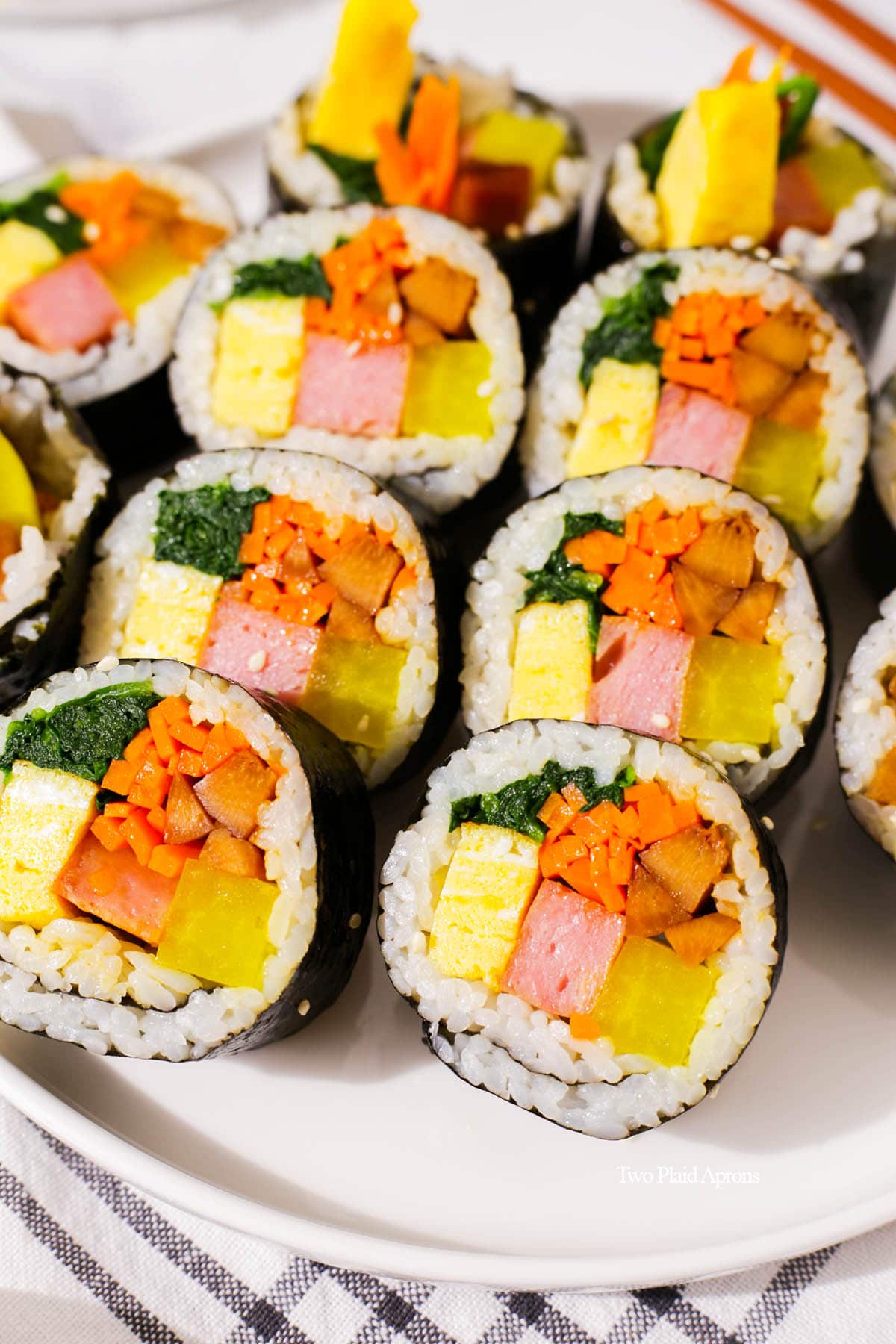
Alternative way to cook eggs for kimbap
If you find the rolled egg omelet style too difficult, you can make egg crepes and cut them into strips.
1. In a large pan over medium high heat, add a small amount of oil. Once the oil is hot, add enough eggs to the pan to completely cover the bottom. Swirl the pan if needed to fill in gaps.
2. Once the egg crepe is cooked on the bottom, flip the whole crepe and cook the other side until done. Remove from the pan and repeat with remaining eggs.
3. When all of the egg crepes are done and cooled enough to handle, cut the crepes into ¼ inch strips. You can do this sheet by sheet or stack them up to cut. Portion into 7 portions, one for each kimbap roll.

What to eat with kimbap
Kimbap on its own is a whole meal, but traditionally, kimbap can be served with some light kimchi soup or fish cake broth for you to dip in. This moisten up the kimbap. You could also drink the soup instead of dipping. Also, try kimbap with a side of fresh kimchi or fermented kimchi for some spice and/or acid!
Recipe tips
- Make the rice a little on the drier side. It doesn't have to be extremely dry. Just a touch drier than your regular steamed white rice is perfect. This is so the rice doesn't become soggy and gummy from the additional seasoning and from mixing.
- Have the seaweed dull side up and the perforated lines on the seaweed should be running up and down, not left to right. When you roll up the kimbap, you should be cutting the kimbap in the same direction of the perforated lines.
- Have all of the ingredients ready at your kimbap rolling station to make the process easier.
- Arrange the ingredients neatly to make the most aesthetically pleasing kimbap rolls.
- If you're new to rolling kimbap, keep your finished kimbap covered to prevent them from drying out.
- You can enjoy kimbap rolls without cutting too. This is especially convenient when you bring kimbap as camping, fish, or any outdoor event. Although cutting them into bite size pieces make them easier to eat.

Storage
If you have leftover kimbap rolls, we recommend keeping the rolls whole and wrapping each one individually in plastic wrap. This will prevent the rice from dry out too much and keeps the kimbap from sticking together. Make sure the kimbap rolls are well wrapped.
Although kimbap taste the best the day of, you can refrigerate it up to 2 to 3 days. The longer you keep it refrigerated, the harder the rice may become.

Reheating
For the first couple of days, you can microwave leftover whole kimbap rolls until they are hot, and the rice will still be soft. Just make sure the kimbap rolls are completely wrapped when reheating. Once they are hot, cut them into slices.
If you've already cut the leftover kimbap rolls into slices, you can pan fry them instead. Just whisk up some eggs and dip the sliced kimbap in the egg. Let the excess drip off then place them into a frying pan over medium high heat with just enough oil to cover the bottom of the pan. Pan fry until the kimbap are golden brown and heated though.

FAQ
Kimbap are usually eaten at room temperature or warm. They should not be eaten chilled because the rice will become hard.
"Kimbap" literally translates to "seaweed rice." It's a seaweed roll made with rice and various fillings of veggies and meat/seafood. "Bibimbap" literally translates to "mixed rice." It's a rice bowl topped with various toppings from veggies to meat. Usually, it's also topped with a fried egg and a gochujang based sauce. Everything is then mixed all together to enjoy. Our easy bibimbap with ground beef is a great example.
Yes, absolutely! Square sushi sheets are perfect for making kimbap.
You should have the seaweed, dull side up and shiny side down. Also, if there are perforated lines on the seaweed, the fillings should be placed perpendicular to the lines. This way, when you cut the kimbap, you are cutting in the same direction of the lines, which will prevent the seaweed from splitting.
If you’ve made this recipe or any recipes from our blog, please tag us on Instagram using #twoplaidaprons! You can also tag us in your Instagram stories using @two_plaid_aprons. We would love to see your creations! It absolutely makes our day! 🥰
📖 Recipe
Spam Kimbap
Ingredients
- 7 cups cooked medium grain white rice a little bit on the drier side (freshly made and hot)
- 10 ounces baby spinach
- 5 large eggs beaten
- 1 can Spam (We used light sodium spam)
- 1 large carrot cut into long thin strips or thin match sticks
- 1 medium danmuji cut into 14 even logs lengthwise (aka yellow pickled radish)
- 14-21 pieces marinated burdock root (optional)
- 7 sheets nori or large dry seaweed for kimbap
- 1½ tablespoons toasted sesame oil divided (plus more for brushing)
- 1½ teaspoon fine salt divided
- Oil as needed for cooking
- Toasted sesame seed (optional for garnish)
Instructions
For the spinach:
- Bring a pot of water to a boil. Place the spinach into the boiling water and cook for about 15 to 30 seconds, or until the spinach is wilted and turns a vibrant, dark green.
- Drain the spinach and rinse with cold water until completely cooled. Firmly squeeze a comfortable handful of the spinach to remove excess water. Repeat with the rest of the spinach.
- Season the spinach with ¼ teaspoon of fine salt and ½ tablespoon of sesame oil. Mix well and set aside.
For the eggs:
- To the beaten eggs, add ¼ teaspoon of fine salt. Mix well.
- In a large nonstick pan over medium heat, add a couple tablespoons of oil. Once the oil is hot, pour half of the the beaten eggs into the pan. Let the eggs cook until they are 70 to 80 percent set. Then start folding the egg over itself from one side, about 2 inches. Keep repeating that 1 to 2 more times.
- Once the egg has been folded about half way, pull it to one side, with the folded up side at the smaller side of the pan. If needed, add a little more oil in the pan, then pour the remaining beaten eggs into the side of the pan where the egg is not folded. Repeat the cooking process and keep folding until the roll completely rolled up and is about 4 to 5 inches in width.
- Remove the egg from the pan and set aside to cool. Once it's cool enough to handle, cut the egg into 7 even strips, lengthwise. Set aside.
For the Spam:
- Cut the Spam into 15 equal logs. You'll have 1 extra log. Snack on it or set it aside for something else.
- In the same large nonstick pan for the eggs, add very small amount of oil and heat it over medium high heat. Once the pan is hot, place the Spam logs in the pan in a single layer. Sear the Spam on each side until golden brown, about 1 to 2 minutes per side. Remove from the pan and set aside.
For the carrots:
- In the same large nonstick pan over medium to medium high heat, add a couple tablespoons of oil. Once the oil is hot, add the carrots and season with ¼ teaspoon of fine salt. Sauté until the carrots are just tender. Remove from the pan and set aside.
For the kimbap rice:
- Fluff up the freshly made rice and either keep it in its cooking vessel or transfer it into a large mixing bowl. Season with ¾ teaspoon of fine salt and 1 tablespoon of sesame oil. Re-fluff the rice to evenly distribute the salt and sesame oil. Keep it warm and covered until ready to assemble kimbap rolls.
Assemble the kimbap rolls:
- Prepare the kimbap rolling station with all of the fillings, rice, and bamboo sushi rolling mat. We like to wrap the sushi mat with plastic wrap to prevent sticking and to keep the mat clean.
- With gloved hands, place a sheet or nori on the sushi mat, dull side up. Place about a cup of the seasoned medium grain rice on the seaweed and spread it out so that the entire sheet is evenly thinly covered. There will be some small gaps here and there, that is okay.
- Place a log of egg, 2 logs of Spam, a log of pickled radish, 2 to 3 pieces of burdock root, and some spinach and carrots around the middle of the rice.
- With the side closest to you, fold the seaweed with rice over the fillings. Tuck and roll all the way to the top of the seaweed. Make sure to hold the kimbap roll firmly the entire time .
- Using the bamboo mat, tuck and firmly squeeze the kimbap roll to reinforce and keep the roll tight and round. Place the finished kimbap roll onto a tray or plate and repeat with the remaining ingredients. Cover the finished kimbap to prevent them from drying out.
- Once all the kimbap rolls are done, use about ½ to 1 tablespoon of sesame oil to lightly brush the top of each roll. You can use a brush or just your gloved fingers. Top with sesame seeds if you wish.
To serve:
- Enjoy the kimbap rolls as they are or cut each roll into 8 to 10 equal pieces so that they're easier to eat. Enjoy!
Notes
- Although the ingredients listed are the classic filling combo for Spam kimbap, if you don't have or can't find certain ingredients, you can omit or substitute them.
- Try your best to not overstuff the kimbap rolls with too much rice! If the layer of rice is too thick, you'll need more rice and you might not be able to fit as much filling.
- If you prefer, please refer to the post for an easier alternative way to cook the eggs.




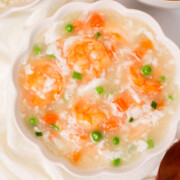






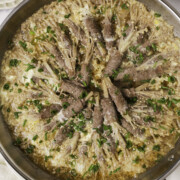







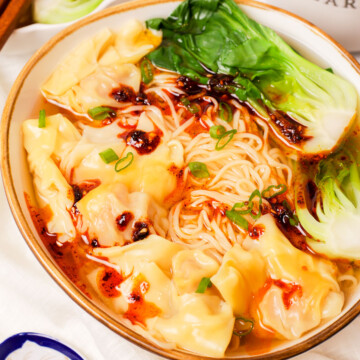
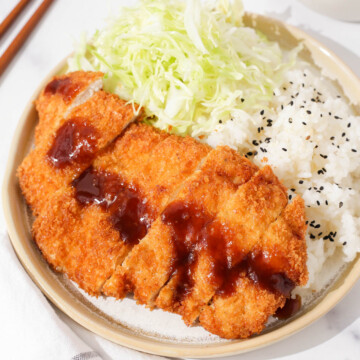

Comments
No Comments